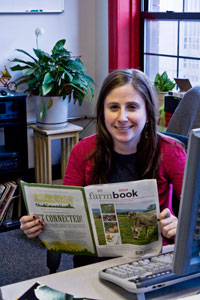
“There are so many opportunities. We wish we were 20 years younger,” Paul Crivellaro mused, sitting across the kitchen table from his wife Ember in their Berks County home. It was a cold, gray December day and the Crivellaros had invited me in for coffee and cookies after a short meet-and-greet with their herd of heritage pigs—hulking beasts with floppy ears and low-key personalities. Trotting amongst the massive backs and inquisitive snouts were troupes of piglets, barely the size of my rotund housecat.
I was interviewing the Crivellaros for the 16-page insert you’ll find in this month’s issue of Grid. Like everyone profiled, they are members of the Pennsylvania Association for Sustainable Agriculture (PASA), our partners for Farmbook 2010.
The Crivellaro’s farm, Country Time, produces some of the best pork around, and in recent years they’ve become the go-to supplier for some of Philadelphia’s top restaurants. Business continues to grow, and the Crivellaros are excited about the future. Hope may not be something most people associate with the small family farm, but it was the overwhelming sentiment among the PASA members I met. They see a way forward through sustainable agriculture, and are excited about serving a community desperate not just for healthy, whole foods, but for a connection to where it comes from. Grid teamed up with PASA because we share that hope, and feel passionately about creating a more localized, sustainable way of living for ourselves and our neighbors.
For me, this assignment was a dream come true. I had the opportunity to meet creative, inspiring farmers and entrepreneurs. I also got out of the office and spent afternoons walking through fields, hanging out with animals and visiting areas that, even as a Philly native, I had never experienced. And, on one exceptionally warm and sunny Friday in January, I had the supreme pleasure of getting caught in the wire fence of Birchrun Hills Farm’s cow pasture, and then reliving the stuggle—it had been captured on my interview recording.
I encountered both young farmers and seasoned veterans in the process of passing along their work to the next generation. I met people who have lived on farms their whole lives and those who barely gardened before adulthood. All of them were not only enthusiastic about discussing their own endeavors—whether it was an experimental cheese, heirloom seeds or a new website—but about pointing me towards friends and neighbors having their own successes.
When you think about it, hopefulness should come naturally to farmers; there is something inherently optimistic about the act of putting seeds in the ground. At its heart it is an act of faith, an investment in the future—the acknowledgment that in a few months time we will all still be here, and hungry for something good to eat.
This month’s Grid is also our first annual House & Home issue. For all the eco-friendly products out there, using what we already have is always the greenest option. “Noble Salvage” focuses on local businesses that turn discarded objects into something useful and aesthetically rich, from a green remodel done with salvage, to tables fashioned from reclaimed wood, to pieces of illuminating art made with flea market finds.


